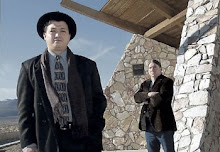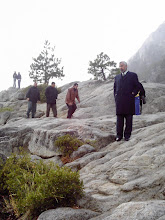Friday, March 28, 2008
MANAGING GROWTH AT THE BIGGEST LITTLE CITY
Working with the Progressive Leadership Alliance of Nevada (PLAN), as a part of their Civic Engagement Project, I will be travelling around the Truckee Meadows working to educate the voters and residents of the area on two very important potential up-coming ballot questions.that impact Northern Nevada and the Truckee Meadows, the "Save our Water" And "Stop Leap Frog Development" campaigns. These are two potential up-coming ballot questions that the Alliance is currently involved in working to inform voters on. The 'Leapfrog development' question is an attempt to rein in a very aggressive annexation policy by the cities in the Truckee Meadows. A similar attempt was made to change the current law last year which failed. For example, Reno has moved from a cherry stem annexations, like Cold Springs and Verdi, to a non-contiguous annexation such as the Winnemucca Ranch area leapfrogging 25 miles north to the border of Pyramid Lake. This type of non-contiguous urban sprawl put unnecessary strain on public infrastructure and public safety resources and complicates jurisdiction and service issues. Successful passage of this initiative would not 'cap' growth, but merely 'manages' it in a reasonable and responsible way by encouraging developers to redevelop areas closer in and the burden and costs to exisiting residencent and voters would significantly decrease for road construction as well as for other public service and infrastructure under a more compact and responsible form of development. Paasage of this initiative would put the regional plan back in compliance with state annexation laws which forbid the cities to annex non-contiguously. What this ballot initiative refers to is "voluntary annexation" which is the type of annexation being used by the cities and developers to subvert the state law, by having a developer buy a ranch or property, and then asks the city for a "voluntary annexation." The very lifestyle that generations of Nevadans have been raised on, and brings people to our region is being threatened by out of control development and irresponsible management. Alan Weber, a noted columnist, visited our area and compared it to Portland and Denver. Weber lauded Portland, OR, as an example of controlled, sustainable growth, and derided Denver as a region where "a gorgeous state" with amble natural beauty "let sprawl and development override the beauty of open space and mountains." To the people of Reno and Sparks, Weber had this to say, "the Reno-Sparks area still has time to choose its direction."
In regard to the 'Save our Water' question, the current master plan for our area calls for 1.2 million residents, while we only have enough water for about 600 thousand residents. In Planning Principle #2 of the Truckee Meadows Regional Plan, it is recognized that our region is "resource constrained" and that water is one of the resources that is constrained. Again, this is not an attempt to stop or 'cap' growth, but again to manage it in a responsible manner. The Truckee Meadows Regional Plan water demand estimates exceed identified water resources by 120%. Washoe County Commissioner Bob Larkins at the Board of County Commissioner meeting held on 3/11/08 conceded that the Spanish Springs area is already "over-allocated" in terms of water needs and usage. The voters of Washoe County have a right to determine the future of the region. The irresponsible and unmanaged growth in Las Vegas has already put our state's and regions water supply at risk.
Lessons from LAS VEGAS -- Seting aside what happened to the Owens Valley, in this city of histrionic and runaway growth (in 2005), in the middle of a five-year drought, the worst in 100 years of record-keeping and perhaps -- tree rings suggest this -- the worst in 500 years, Las Vegas's water came mostly from Lake Mead -- which in 2005, was down to 59 percent of capacity -- and, upstream from Mead, Lake Powell, which was at 34 percent of capacity, its lowest since it started filling three decades before. The Colorad River doesn't even reach the Gulf of Mexico anymore. The lower course of the river, which forms the border between Baja California and Sonora, is essentially a trickle or a dry stream today due to use of the river as Imperial Valley's irrigation source. Prior to the mid 20th century, the Colorado River Delta provided a rich estuarine marshland that is now essentially desiccated, but nonetheless is an important ecological resource.
The Strip -- the portion of Las Vegas Boulevard that has 15 of the world's 20 largest hotels -- features vast fountains, a sea battle between pirate ships and an 8.5-acre lake in front of the Bellagio Hotel and Casino. According to ABC News (April 2007) Las Vegas has become the fastest-growing city in the nation. Its population is currently 1.8 million, and is projected to hit 3 million by 2020. Las Vegas is a city with a ferocious thirst that it's having a hard time slaking. The major water supply for Las Vegas comes from the Colorado River, which has undergone a drought as a result of climate change, says Pat Mulroy, of the Southern Nevada Water Authority.
"Climate change is here," Mulroy, the city's water czar for almost 20 years, says. "We've been living it for the last eight years. The drought on the Colorado River was a rude wake-up call. Frankly, when 90 percent of your water comes from one river that is predicted to have massive water shortages, you'd be irresponsible not to develop water supplies that are independent of that river system in order to diversify." The plan for diversification is controversial. Mulroy divised the controversial plan to build a $2 billion pipeline that would pump water out of White Pine County and send it down to feed the growing water needs of southern Nevada. Specifically, the Snake Valley, in White Pine County, Nev., straddling the Utah border. This area is home to cattle ranches, alfalfa farms and endangered species, it's people who are few and far between along this desert landscape. That's because the Snake Valley is dry -- one of the driest parts of the driest state in the union, getting only about 8 inches of rainfall every year.
The Southern Nevada Water Authority and its water "czar," Patricia Mulroy, seeks to tap 65 billion gallons of rural water a year with a 300-mile-long pipeline expected to cost more than $2 billion. That's enough water for 50,000 families a year. Las Vegas's unmanaged growth has now impacted other Nevadans, like Dean Baker and Cecil Garland, who both operate ranches in Utah and Nevada. But even the Water Czar could not avoid conceding "There isn't enough water to go around," Mulroy told NPR in a 1991 story about the early stages of the project. "And we're the most arid spot in the United States." Las Vegas, a city known for its excess, has exceeded not onlt its own surface and ground water sources, as well as the Colorado River, but now expect other Nevada communities and families to sacrifice their life styles and communities for the sake of unmanaged growth. "What Las Vegas has got to learn is that there are limits to its growth," Garland says. He also applies his own value judgment to the competing uses for water. "Gluttony, glitter girls and gambling are what [Las Vegas] is all about," the 81-year-old rancher asserts. "What it's all about here [in Snake Valley] is children, cattle, country and church."
It is quite simply reckless and irresponsible to implement any growth plan that ignores or fails to consider the availability of water in Washoe County, and to ask other communities in our state to pay far or shoulder the burden of our lack of responsible planning.
The research for this article was provided by the Progressive Leadership Alliance, by Howard Berkes of NPR, by Terry Moran and Katie Hinman, ABC News, and George F. Will of the Washington Post.
In regard to the 'Save our Water' question, the current master plan for our area calls for 1.2 million residents, while we only have enough water for about 600 thousand residents. In Planning Principle #2 of the Truckee Meadows Regional Plan, it is recognized that our region is "resource constrained" and that water is one of the resources that is constrained. Again, this is not an attempt to stop or 'cap' growth, but again to manage it in a responsible manner. The Truckee Meadows Regional Plan water demand estimates exceed identified water resources by 120%. Washoe County Commissioner Bob Larkins at the Board of County Commissioner meeting held on 3/11/08 conceded that the Spanish Springs area is already "over-allocated" in terms of water needs and usage. The voters of Washoe County have a right to determine the future of the region. The irresponsible and unmanaged growth in Las Vegas has already put our state's and regions water supply at risk.
Lessons from LAS VEGAS -- Seting aside what happened to the Owens Valley, in this city of histrionic and runaway growth (in 2005), in the middle of a five-year drought, the worst in 100 years of record-keeping and perhaps -- tree rings suggest this -- the worst in 500 years, Las Vegas's water came mostly from Lake Mead -- which in 2005, was down to 59 percent of capacity -- and, upstream from Mead, Lake Powell, which was at 34 percent of capacity, its lowest since it started filling three decades before. The Colorad River doesn't even reach the Gulf of Mexico anymore. The lower course of the river, which forms the border between Baja California and Sonora, is essentially a trickle or a dry stream today due to use of the river as Imperial Valley's irrigation source. Prior to the mid 20th century, the Colorado River Delta provided a rich estuarine marshland that is now essentially desiccated, but nonetheless is an important ecological resource.
The Strip -- the portion of Las Vegas Boulevard that has 15 of the world's 20 largest hotels -- features vast fountains, a sea battle between pirate ships and an 8.5-acre lake in front of the Bellagio Hotel and Casino. According to ABC News (April 2007) Las Vegas has become the fastest-growing city in the nation. Its population is currently 1.8 million, and is projected to hit 3 million by 2020. Las Vegas is a city with a ferocious thirst that it's having a hard time slaking. The major water supply for Las Vegas comes from the Colorado River, which has undergone a drought as a result of climate change, says Pat Mulroy, of the Southern Nevada Water Authority.
"Climate change is here," Mulroy, the city's water czar for almost 20 years, says. "We've been living it for the last eight years. The drought on the Colorado River was a rude wake-up call. Frankly, when 90 percent of your water comes from one river that is predicted to have massive water shortages, you'd be irresponsible not to develop water supplies that are independent of that river system in order to diversify." The plan for diversification is controversial. Mulroy divised the controversial plan to build a $2 billion pipeline that would pump water out of White Pine County and send it down to feed the growing water needs of southern Nevada. Specifically, the Snake Valley, in White Pine County, Nev., straddling the Utah border. This area is home to cattle ranches, alfalfa farms and endangered species, it's people who are few and far between along this desert landscape. That's because the Snake Valley is dry -- one of the driest parts of the driest state in the union, getting only about 8 inches of rainfall every year.
The Southern Nevada Water Authority and its water "czar," Patricia Mulroy, seeks to tap 65 billion gallons of rural water a year with a 300-mile-long pipeline expected to cost more than $2 billion. That's enough water for 50,000 families a year. Las Vegas's unmanaged growth has now impacted other Nevadans, like Dean Baker and Cecil Garland, who both operate ranches in Utah and Nevada. But even the Water Czar could not avoid conceding "There isn't enough water to go around," Mulroy told NPR in a 1991 story about the early stages of the project. "And we're the most arid spot in the United States." Las Vegas, a city known for its excess, has exceeded not onlt its own surface and ground water sources, as well as the Colorado River, but now expect other Nevada communities and families to sacrifice their life styles and communities for the sake of unmanaged growth. "What Las Vegas has got to learn is that there are limits to its growth," Garland says. He also applies his own value judgment to the competing uses for water. "Gluttony, glitter girls and gambling are what [Las Vegas] is all about," the 81-year-old rancher asserts. "What it's all about here [in Snake Valley] is children, cattle, country and church."
It is quite simply reckless and irresponsible to implement any growth plan that ignores or fails to consider the availability of water in Washoe County, and to ask other communities in our state to pay far or shoulder the burden of our lack of responsible planning.
The research for this article was provided by the Progressive Leadership Alliance, by Howard Berkes of NPR, by Terry Moran and Katie Hinman, ABC News, and George F. Will of the Washington Post.
Labels: wow
development,
PLAN,
Roces,
Truckee Meadows,
Water
Subscribe to:
Post Comments (Atom)





+of+2-27-2007-040.jpg)





















No comments:
Post a Comment